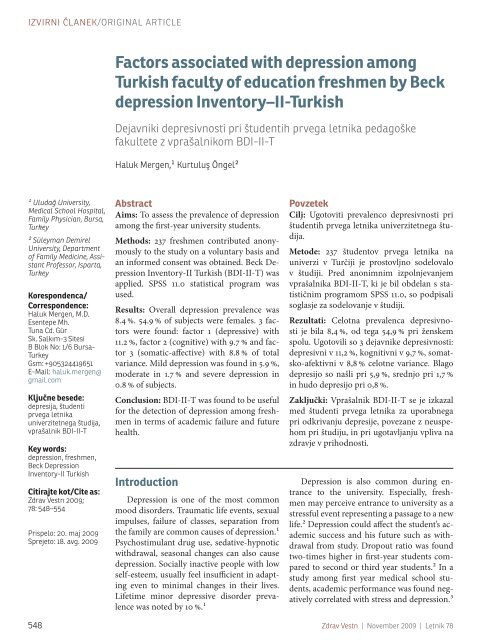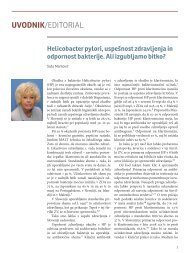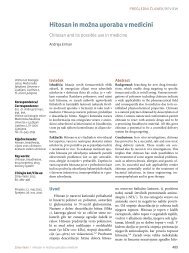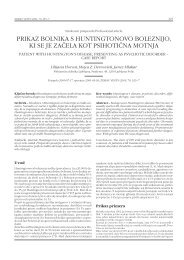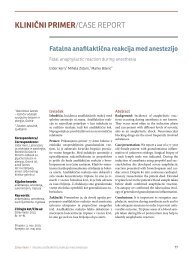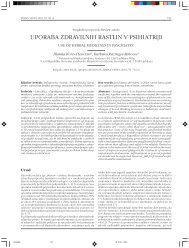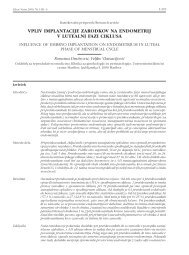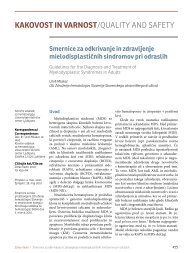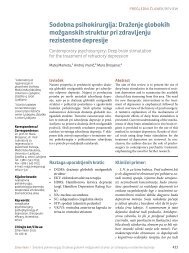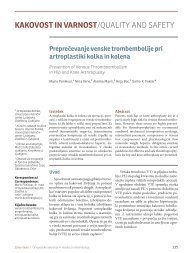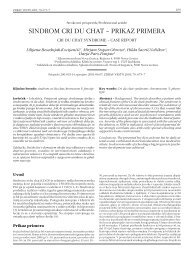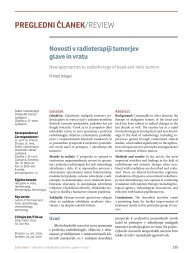Depression factors in Turkish freshmen by BDI-II-T Factors ...
Depression factors in Turkish freshmen by BDI-II-T Factors ...
Depression factors in Turkish freshmen by BDI-II-T Factors ...
Create successful ePaper yourself
Turn your PDF publications into a flip-book with our unique Google optimized e-Paper software.
IZVIRNI ČLANEK/ORIGINAL ARTICLE<br />
<strong>Depression</strong><br />
<strong>factors</strong> <strong>in</strong><br />
<strong>Turkish</strong><br />
<strong>freshmen</strong> <strong>by</strong><br />
<strong>BDI</strong>-<strong>II</strong>-T<br />
<strong>Factors</strong> associated with depression among<br />
<strong>Turkish</strong> faculty of education <strong>freshmen</strong> <strong>by</strong> Beck<br />
depression Inventory–<strong>II</strong>-<strong>Turkish</strong><br />
Dejavniki depresivnosti pri študentih prvega letnika pedagoške<br />
fakultete z vprašalnikom <strong>BDI</strong>-<strong>II</strong>-T<br />
Haluk Mergen,¹ Kurtuluş Öngel²<br />
¹ Uludağ University,<br />
Medical School Hospital,<br />
Family Physician, Bursa,<br />
Turkey<br />
² Süleyman Demirel<br />
University, Department<br />
of Family Medic<strong>in</strong>e, Assistant<br />
Professor, Isparta,<br />
Turkey<br />
Korespondenca/<br />
Correspondence:<br />
Haluk Mergen, M.D.<br />
Esentepe Mh.<br />
Tuna Cd. Gür<br />
Sk. Salkım-3 Sitesi<br />
B Blok No: 1/6 Bursa-<br />
Turkey<br />
Gsm: +905324419651<br />
E-Mail: haluk.mergen@<br />
gmail.com<br />
Ključne besede:<br />
depresija, študenti<br />
prvega letnika<br />
univerzitetnega študija,<br />
vprašalnik <strong>BDI</strong>-<strong>II</strong>-T<br />
Key words:<br />
depression, <strong>freshmen</strong>,<br />
Beck <strong>Depression</strong><br />
Inventory-<strong>II</strong> <strong>Turkish</strong><br />
Citirajte kot/Cite as:<br />
Zdrav Vestn 2009;<br />
78: 548–554<br />
Prispelo: 20. maj 2009<br />
Sprejeto: 18. avg. 2009<br />
Abstract<br />
Aims: To a ssess the prevalence of depression<br />
among the first-year university students.<br />
Methods: 237 <strong>freshmen</strong> contributed anonymously<br />
to the study on a voluntary basis and<br />
an <strong>in</strong>formed consent was obta<strong>in</strong>ed. Beck <strong>Depression</strong><br />
Inventory-<strong>II</strong> <strong>Turkish</strong> (<strong>BDI</strong>-<strong>II</strong>-T) was<br />
applied. SPSS 11.0 statistical program was<br />
used.<br />
Results: Overall depression prevalence was<br />
8.4 %. 54.9 % of subjects were females. 3 <strong>factors</strong><br />
were found: factor 1 (depressive) with<br />
11.2 %, factor 2 (cognitive) with 9.7 % and factor<br />
3 (somatic-affective) with 8.8 % of total<br />
variance. Mild depression was found <strong>in</strong> 5.9 %,<br />
moderate <strong>in</strong> 1.7 % and severe depression <strong>in</strong><br />
0.8 % of subjects.<br />
Conclusion: <strong>BDI</strong>-<strong>II</strong>-T was found to be useful<br />
for the detection of depression among <strong>freshmen</strong><br />
<strong>in</strong> terms of academic failure and future<br />
health.<br />
Introduction<br />
<strong>Depression</strong> is one of the most common<br />
mood disorders. Traumatic life events, sexual<br />
impulses, failure of classes, separation from<br />
the family are common causes of depression.1<br />
Psychostimulant drug use, sedative-hypnotic<br />
withdrawal, seasonal changes can also cause<br />
depression. Socially <strong>in</strong>active people with low<br />
self-esteem, usually feel <strong>in</strong>sufficient <strong>in</strong> adapt<strong>in</strong>g<br />
even to m<strong>in</strong>imal changes <strong>in</strong> their lives.<br />
Lifetime m<strong>in</strong>or depressive disorder prevalence<br />
was noted <strong>by</strong> 10 %.1<br />
Povzetek<br />
Cilj: Ugotoviti prevalenco depresivnosti pri<br />
študentih prvega letnika univerzitetnega študija.<br />
Metode: 237 študentov prvega letnika na<br />
univerzi v Turčiji je prostovljno sodelovalo<br />
v študiji. Pred anonimnim izpolnjevanjem<br />
vprašalnika <strong>BDI</strong>-<strong>II</strong>-T, ki je bil obdelan s statističnim<br />
programom SPSS 11.0, so podpisali<br />
soglasje za sodelovanje v študiji.<br />
Rezultati: Celotna prevalenca depresivnosti<br />
je bila 8,4 %, od tega 54,9 % pri ženskem<br />
spolu. Ugotovili so 3 dejavnike depresivnosti:<br />
depresivni v 11,2 %, kognitivni v 9,7 %, somatsko-afektivni<br />
v 8,8 % celotne variance. Blago<br />
depresijo so našli pri 5,9 %, srednjo pri 1,7 %<br />
<strong>in</strong> hudo depresijo pri 0,8 %.<br />
Zaključki: Vprašalnik <strong>BDI</strong>-<strong>II</strong>-T se je izkazal<br />
med študenti prvega letnika za uporabnega<br />
pri odkrivanju depresije, povezane z neuspehom<br />
pri študiju, <strong>in</strong> pri ugotavljanju vpliva na<br />
zdravje v prihodnosti.<br />
<strong>Depression</strong> is also common dur<strong>in</strong>g entrance<br />
to the university. Especially, <strong>freshmen</strong><br />
may perceive entrance to university as a<br />
stressful event represent<strong>in</strong>g a passage to a new<br />
life.2 <strong>Depression</strong> could affect the student’s academic<br />
success and his future such as withdrawal<br />
from study. Dropout ratio was found<br />
two-times higher <strong>in</strong> first-year students compared<br />
to second or third year students.2 In a<br />
study among first year medical school students,<br />
academic performance was found negatively<br />
correlated with stress and depression.3<br />
548 Zdrav Vestn | November 2009 | Letnik 78
IZVIRNI ČLANEK/ORIGINAL ARTICLE<br />
Moreover, a prom<strong>in</strong>ent <strong>in</strong>verse relationship<br />
was found between years of study and mental<br />
health among university students. Especially,<br />
<strong>freshmen</strong> are at great risk for depression.4<br />
Beck <strong>Depression</strong> Inventory has been developed<br />
primarily <strong>by</strong> Beck et al. <strong>in</strong> 1961 and<br />
revised <strong>in</strong> 1996.5,6 Hisli did the <strong>Turkish</strong> validation<br />
of <strong>BDI</strong>-<strong>II</strong>.7<br />
Because of its risks for educational life<br />
and health of the students, depression must<br />
be quested. Moreover, depression may cause<br />
emergent conditions like suicide. Accord<strong>in</strong>g<br />
to researches, females were two times more<br />
prone to depression compared to males.1 Low<br />
socioeconomic status and low educational<br />
level were among the major risk <strong>factors</strong>.<br />
Faculty of Education of Celal Bayar University<br />
is located <strong>in</strong> a mounta<strong>in</strong>ous small<br />
town, Demirci, far distant to the ma<strong>in</strong> campus<br />
situated <strong>in</strong> the city (approximately 160 km<br />
distant). Meanwhile, 3200 students had been<br />
there <strong>in</strong> total, of which 915 were <strong>freshmen</strong>.<br />
State had built some youth hostels with a capacity<br />
of 2000 persons <strong>in</strong> total there. However,<br />
psychosocial and health needs were never<br />
met and it has been always labeled as a region<br />
of deprivation.<br />
Because this subject was important, we<br />
aimed to assess the prevalence of depression<br />
and its precipitators among <strong>freshmen</strong>.<br />
Materials & methods<br />
This study is performed at Celal Bayar University,<br />
Faculty of Education, Demirci, Manisa,<br />
Turkey <strong>in</strong> May 2006. Out of n<strong>in</strong>e hundred and<br />
fifteen <strong>freshmen</strong>, 237 participated <strong>in</strong> Beck <strong>Depression</strong><br />
Inventory-<strong>II</strong> <strong>Turkish</strong> (<strong>BDI</strong>-<strong>II</strong>-T) on<br />
a voluntary basis.6,7 The test constituted of<br />
21 questions reveal<strong>in</strong>g mood state of the subject.<br />
Each question scored 0 to 3. <strong>Depression</strong><br />
scores less than 10 were accepted as normal;<br />
10–16 were accepted as mild depression, 17–29<br />
as moderate, 30–39 severe depression and<br />
greater than 39 very severe depression.7 Statistical<br />
Package for the Social Sciences (SPSS,<br />
Chicago, IL, version 11.0) was used to analyze<br />
the data. Numerical data were expressed as arithmetical<br />
means ± 1 standard deviation. Student’s<br />
t-test and one-way ANOVA test used to<br />
analyze the data. A p-value of less than 0.05<br />
was considered statistically significant.<br />
Results<br />
Of the 237 <strong>freshmen</strong> who contributed,<br />
overall depression ratio was 8.4 %. Demographic<br />
data are presented <strong>in</strong> Table 1. Mean<br />
age was 18.12 ± 1.35 (SD), ranged from 15 to<br />
27 years. Almost 90 % of depressive students<br />
were less than 20 years old (Table 1). Mild depression<br />
was found <strong>in</strong> 5.9 %, moderate <strong>in</strong> 1.7 %<br />
and severe depression <strong>in</strong> 0.8 % of subjects.<br />
Internal consistency of <strong>BDI</strong>-<strong>II</strong>-T was<br />
found α=0.832. Mean item-total score correlation<br />
coefficients were found 0.473 (rang<strong>in</strong>g<br />
from 0.324 to 0.630). Kaiser-Meyer-Olk<strong>in</strong><br />
sampl<strong>in</strong>g adequacy measure was found to be<br />
0.773. Bartlett’s sphericity test was found significant.<br />
These two tests results have allowed<br />
us to do factor analysis of <strong>BDI</strong>-<strong>II</strong>-T. Accord<strong>in</strong>g<br />
to pr<strong>in</strong>cipal component analysis <strong>by</strong> the<br />
Varimax rotation with Kaiser Normalization,<br />
the eigenvalues over 1 were: 4.993, 1.890, 1.494,<br />
1.239, 1.162, 1.074 and 1.029. Therefore, we<br />
have determ<strong>in</strong>ed seven <strong>factors</strong>. Of the 7 factor<br />
weights, 0.40 was considered as the criteria<br />
value. Accord<strong>in</strong>g to the criteria value, 3 <strong>factors</strong><br />
were <strong>in</strong>terpreted (Table 2). We can group<br />
Factor 1 (item no.1 sadness, item no.2 pessimism,<br />
item no.4 loss of pleasure, item no.5<br />
guilt feel<strong>in</strong>g, item no.7 self-dislike, item no.12<br />
loss of <strong>in</strong>terest) depressive; Factor 2 (item no.1<br />
sadness, item no.3 past failure, item no.8 selfcriticalness,<br />
item no.9 suicidal thoughts or<br />
wishes, item no.13 <strong>in</strong>decisiveness, item no.16<br />
sleep<strong>in</strong>g patterns change) cognitive; Factor 3<br />
(item no.10 cry<strong>in</strong>g spells, item no.11 agitation,<br />
item no.12 loss of <strong>in</strong>terest, item no.18 change<br />
<strong>in</strong> appetite, item no.19 weight loss) somaticaffective<br />
<strong>factors</strong> of <strong>BDI</strong>-<strong>II</strong>-T.<br />
Feel<strong>in</strong>gs of punishment, worthlessness and<br />
cry<strong>in</strong>g were found to be significantly higher<br />
among males compared to females (p = 0.037;<br />
p = 0.024; p = 0.020, respectively).<br />
A significant relationship was found between<br />
depression scores and the <strong>BDI</strong>-<strong>II</strong> questions<br />
answered <strong>by</strong> subjects (all p=0.00) (Table<br />
3).<br />
No significant relationship was found<br />
between pessimism and past failure, pessimism<br />
and feel<strong>in</strong>gs of punishment, pessimism<br />
and self-criticalness, pessimism and suicidal<br />
thoughts or wishes and pessimism and agitation.<br />
<strong>Factors</strong> associated with depression among <strong>Turkish</strong> faculty of education <strong>freshmen</strong> <strong>by</strong> Beck depression Inventory–<strong>II</strong>-<strong>Turkish</strong> 549
IZVIRNI ČLANEK/ORIGINAL ARTICLE<br />
Regard<strong>in</strong>g the relationship between selfdislike<br />
and age of the subjects, subjects between<br />
20 and 25 years old were found to<br />
appreciate themselves. However, subjects<br />
younger than 20 years were found to dislike<br />
themselves (Somer’s d = –0.069, p = 0.003). A<br />
significant relationship was found between<br />
cry<strong>in</strong>g and loss of energy (Somer’s d = 0.290,<br />
p = 0.002). There was significant relationship<br />
between pessimism, past failure, feel<strong>in</strong>gs of<br />
punishment and guilty.<br />
In addition, no significant relationship<br />
was found between agitation and pessimism,<br />
past failure and self-dislike. The relationship<br />
between <strong>in</strong>decisiveness and past failure,<br />
punishment, self-dislike, self-criticalness and<br />
agitation were statistically <strong>in</strong>significant. No<br />
significant relationship found between loss of<br />
<strong>in</strong>terest <strong>in</strong> sex and sadness, pessimism, past<br />
failure, self-dislike, suicidal thoughts or wishes<br />
and agitation.<br />
Mult<strong>in</strong>omial logistic regression test <strong>in</strong>dicates<br />
a statistically significant relationship<br />
between high depression scores, gender, age<br />
and all of the <strong>in</strong>ventory questions (R2 = 1.0,<br />
p = 0.000).<br />
Table 1: General Characteristics of Depressive Students<br />
Students n %<br />
Gender<br />
Male 107 45.1<br />
Female 130 54.9<br />
Dwell<strong>in</strong>g<br />
City 36 15.2<br />
Village 82 34.6<br />
Small town 119 50.2<br />
Monthly <strong>in</strong>come<br />
< 300 $ 83 35.0<br />
300–600 $ 118 49.8<br />
> 600 $ 36 15.2<br />
Family <strong>Depression</strong> History<br />
Yes 59 24.9<br />
No 178 75.1<br />
Severity<br />
Mild depression 14 5.9<br />
Moderate depression 4 1.7<br />
Severe depression 2 0.8<br />
Age Under 20 y.o. 20–25 y.o.<br />
n % n %<br />
220 92.8 17 7.2<br />
Male 80 33.8 9 52.9<br />
Female 140 59.1 8 47.1<br />
y.o.: years old<br />
550 Zdrav Vestn | November 2009 | Letnik 78
IZVIRNI ČLANEK/ORIGINAL ARTICLE<br />
Follow<strong>in</strong>g the comparison of depressed<br />
students with non-depressed students <strong>by</strong><br />
one-way ANOVA test; the <strong>in</strong>fluence of gender,<br />
age, suicidal thoughts and past failure<br />
were found to be <strong>in</strong>significant (p > 0.05). All<br />
the other questions <strong>in</strong> the <strong>in</strong>ventory (sadness,<br />
pessimism, loss of pleasure, guilt feel<strong>in</strong>g, punishment<br />
feel<strong>in</strong>g, self-dislike, self-criticalness<br />
(accusation), cry<strong>in</strong>g, agitation, loss of <strong>in</strong>terest,<br />
<strong>in</strong>decisiveness, worthlessness, loss of energy,<br />
changes <strong>in</strong> sleep<strong>in</strong>g patterns, fatigue, changes<br />
<strong>in</strong> appetite, weight loss, somatic concern, loss<br />
Table 2: Varimax rotated iterated pr<strong>in</strong>cipal factor analysis of <strong>BDI</strong>-<strong>II</strong>-T for an educational faculty<br />
<strong>freshmen</strong> sample. Values for items weights greater than 0.40 are highlighted <strong>in</strong> bold.<br />
Factor 1 Factor 2 Factor 3 Factor 4 Factor 5 Factor 6 Factor 7<br />
Total<br />
Variance<br />
Variance % 11.2 % 9.7 % 9.5 % 8.8 % 7.9 % 7.4 % 6.9 % 61.4 %<br />
Factor 1<br />
(Depressive)<br />
2. Pessimism 0.705<br />
7. Self-dislike 0.666<br />
Factor2<br />
(Cognitive)<br />
1. Sadness 0.619 0.416<br />
Factor3<br />
4. Loss of pleasure 0.560 0.306<br />
14. Worthlessness 0.796<br />
Factor4<br />
(Somaticaffective)<br />
Factor5 Factor6 Factor7<br />
8. Self-criticalness<br />
0.522 0.358<br />
(accusation)<br />
3. Past Failure 0.515 -0.391 0.330<br />
17. Fatigue 0.739<br />
9. Suicidal thoughts<br />
0.484 0.672<br />
or wishes<br />
15. Loss of energy 0.489 0.401 0.343<br />
10. Cry<strong>in</strong>g 0.379 0.348 -0.325<br />
11. Agitation 0.725<br />
18. Changes<br />
0.327 0.651<br />
<strong>in</strong> appetite<br />
19. Weight loss 0.537 0.352 0.427<br />
12. Loss of <strong>in</strong>terest 0.472 0.517<br />
6. Punishment feel<strong>in</strong>g 0.712<br />
5. Guilt feel<strong>in</strong>g 0.324 0.706<br />
21. Loss of<br />
<strong>in</strong>terest <strong>in</strong> sex<br />
0.802<br />
13. Indecisiveness 0.340 0.510<br />
20. Somatic concern 0.646<br />
16. Changes <strong>in</strong><br />
sleep<strong>in</strong>g patterns<br />
0.322 0.576<br />
<strong>Factors</strong> associated with depression among <strong>Turkish</strong> faculty of education <strong>freshmen</strong> <strong>by</strong> Beck depression Inventory–<strong>II</strong>-<strong>Turkish</strong> 551
IZVIRNI ČLANEK/ORIGINAL ARTICLE<br />
of <strong>in</strong>terest <strong>in</strong> sex) were found to be significant<br />
(p < 0.05). There were no significant differences<br />
between the depression scores and the<br />
<strong>in</strong>come levels of family and dwell<strong>in</strong>gs of the<br />
<strong>freshmen</strong>. Cronbach’s α coefficient was found<br />
to be 0.832.<br />
Discussion<br />
At the beg<strong>in</strong>n<strong>in</strong>g of the study, the depression<br />
level was proposed to be high among<br />
<strong>freshmen</strong> because of the distant localization<br />
of the faculty to a rural area and <strong>in</strong>sufficient<br />
social facilities. However, the results of the<br />
study showed that the ratio of depression<br />
among <strong>freshmen</strong> was only 8.4 % and with<br />
a high female preponderence. In a similar<br />
study performed <strong>in</strong> Turkey, depression ratio<br />
was found 12.5 %, with female dom<strong>in</strong>ance.8 In<br />
another study with a larger participation, depression<br />
level was found to be 21 % with male<br />
predom<strong>in</strong>ance, which was different from both<br />
literature and our study.4 Female gender and<br />
hopelessness were found as predictors of depression<br />
<strong>in</strong> another study.9 Life stress, social<br />
support and cop<strong>in</strong>g skills were found as salient<br />
<strong>factors</strong> of depression among girls. As<br />
stated above, depression prevalence was found<br />
to be higher among females than men <strong>in</strong> this<br />
and similar studies. Both physical and sexual<br />
Table 3: <strong>Depression</strong> Scores versus Beck <strong>Depression</strong> Inventory-<strong>II</strong> <strong>Turkish</strong> (<strong>BDI</strong>-<strong>II</strong>-T)<br />
Questions of the Subjects<br />
Pearson Correlation<br />
Coefficient (r)<br />
p<br />
Sadness 0.506 0.000*<br />
Pessimism 0.324 0.000*<br />
Past Failure 0.327 0.000*<br />
Loss of pleasure 0.546 0.000*<br />
Guilt feel<strong>in</strong>g 0.438 0.000*<br />
Punishment feel<strong>in</strong>g 0.467 0.000*<br />
Self-dislike 0.324 0.000*<br />
Self-criticalness (accusation) 0.563 0.000*<br />
Suicidal thoughts or wishes 0.374 0.000*<br />
Cry<strong>in</strong>g 0.528 0.000*<br />
Agitation 0.449 0.000*<br />
Loss of <strong>in</strong>terest 0.517 0.000*<br />
Indecisiveness 0.593 0.000*<br />
Worthlessness 0.468 0.000*<br />
Loss of energy 0.576 0.000*<br />
Changes <strong>in</strong> sleep<strong>in</strong>g patterns 0.620 0.000*<br />
Fatigue 0.476 0.000*<br />
Changes <strong>in</strong> appetite 0.630 0.000*<br />
Weight loss 0.343 0.000*<br />
Somatic concern 0.408 0.000*<br />
Loss of <strong>in</strong>terest <strong>in</strong> sex 0.461 0.000*<br />
* p=0.000<br />
552 Zdrav Vestn | November 2009 | Letnik 78
IZVIRNI ČLANEK/ORIGINAL ARTICLE<br />
abuses are important <strong>factors</strong> for depression,<br />
especially sexual abuse is more important for<br />
depression seen <strong>in</strong> males.10 However, sexual<br />
abuse was not questioned <strong>in</strong> this study due to<br />
cultural properties.<br />
Self-criticism and submissive behavior,<br />
<strong>in</strong>somnia, nightmares were found to be important<br />
<strong>factors</strong> related to depression.11,12<br />
Especially, sleep<strong>in</strong>g problems were found to<br />
predict future depression quite accurately <strong>in</strong><br />
adolescent boys and girls.13 <strong>Depression</strong> and<br />
low self-esteem are <strong>in</strong>dependently associated<br />
with suicidal thoughts. In this study, depression<br />
was not found to be related to suicide<br />
because only few students had answered this<br />
question.14,15 Defense mechanisms aga<strong>in</strong>st<br />
depression were analyzed previously, where<br />
stress reactivity <strong>in</strong> response to m<strong>in</strong>or stressors<br />
was found to be a stronger predictor of<br />
depression rather than total stress. Stress reactivity<br />
was found to be related with neuroticism,<br />
traits of depression, anxiety and vulnerability<br />
to stress.16 Moreover, anger was found<br />
to be with a low ratio of depression, while<br />
depression mood was found to be related to<br />
negative mood profile and decreased goalconfidence.17<br />
Pessimism and agitation, which<br />
were considered as improper reactions aga<strong>in</strong>st<br />
stress, were found to be statistically significant<br />
predictors of depression <strong>in</strong> this study.<br />
Survivor guilt, omnipotent responsibility<br />
guilt, submissive behavior, fear of negative<br />
evaluation, fear of envy, empathic distress,<br />
lower <strong>in</strong> social comparison are associated<br />
with depression.18 We found also a good correlation<br />
between high depression scores and<br />
guilt, feel<strong>in</strong>gs of punishment, self-dislike and<br />
self-criticism <strong>in</strong> our study. Moreover, autonomic,<br />
sociotropic vulnerability and selfcriticism<br />
are also associated with fearful and<br />
preoccupied adult attachment models and<br />
depression.19<br />
In another study analyz<strong>in</strong>g the personal<br />
vulnerability <strong>factors</strong>, developmental experiences<br />
and recent family history <strong>in</strong>formation<br />
were found to be associated with cl<strong>in</strong>ical depression.20<br />
In our study, history of a psychiatric<br />
event <strong>in</strong> family was 24.9 % which is quite<br />
high compared to Wong’s study, where the<br />
ratio was found as 8 %.4<br />
Neurotic perfectionism also has a relationship<br />
with depression and psychosomatic<br />
symptoms.21 Self-criticism, self-dislike and<br />
<strong>in</strong>decisiveness have all been found to contribute<br />
to depression.<br />
In our study, students less than 20 years<br />
disliked themselves much more than those<br />
who were between 20–25 years. This is possibly<br />
because students get more stable and mature<br />
so that their character stabilizes with age.<br />
Goal-confidence and self-esteem were found<br />
to <strong>in</strong>crease with age, which supports our f<strong>in</strong>d<strong>in</strong>g.17<br />
<strong>Depression</strong> may affect academic performance<br />
among university students. School<br />
absenteeism has been found to be frequent<br />
<strong>in</strong> depression.22 Substance abuse, impaired<br />
social function<strong>in</strong>g may be triggered <strong>in</strong>to<br />
adulthood with 60–70 % risk of depression.23<br />
Furthermore, it is important to diagnose<br />
depression early. One of the most common<br />
reasons why students adm<strong>in</strong>ister the counsel<strong>in</strong>g<br />
centers is depression.24 Therefore, experienced<br />
health care professionals must pay<br />
attention to the early diagnosis of a possible<br />
depression among <strong>freshmen</strong> and f<strong>in</strong>d possible<br />
precautions to prevent depression among<br />
university students.<br />
Conclusion<br />
In conclusion, all school based health center<br />
physicians must recognize student depression<br />
and be ready for early treatment. <strong>Depression</strong><br />
is not a negligible situation which could<br />
affect the person’s both daily life and academic<br />
performance.<br />
References<br />
1. Sadock BJ. Duygu-durum Bozuklukları<br />
(Mood Disorders). In: Kaplan HI, Sadock BJ,<br />
eds. Abay E, Caliyurt O, Tuglu C, translators.<br />
Kl<strong>in</strong>ik Psikiyatri El Kitabı, Nobel Tıp Kitapevi,<br />
İstanbul, 1999. (translated from Pocket Handbook<br />
of Cl<strong>in</strong>ical Psychiatry. 2nd ed. Williams &<br />
Wilk<strong>in</strong>s, New York, 1995), p.100–10.<br />
2. Voelker R. Mount<strong>in</strong>g Student <strong>Depression</strong> Tax<strong>in</strong>g<br />
Campus Mental Health Services. JAMA,<br />
2003, 289: 2055–56.<br />
3. Lam S, Betson W&W. A prospective analysis<br />
of stress and academic performance <strong>in</strong> the first<br />
two years of medical school. Medical Education,<br />
2002, 33(4): 243–50.<br />
4. Wong et al. Web-Based Survey of <strong>Depression</strong>,<br />
Anxiety And Stress <strong>in</strong> First-Year Tertiary Education<br />
Students <strong>in</strong> Hong Kong. Australian and<br />
<strong>Factors</strong> associated with depression among <strong>Turkish</strong> faculty of education <strong>freshmen</strong> <strong>by</strong> Beck depression Inventory–<strong>II</strong>-<strong>Turkish</strong> 553
IZVIRNI ČLANEK/ORIGINAL ARTICLE<br />
New Zealand Journal of Psychiatry, 2006, 40:<br />
777–82.<br />
5. Beck, AT, Steer, RA, Brown GK. Beck <strong>Depression</strong><br />
Inventory-Second Edition Manual. San<br />
Antonio, TX: The Psychological Corporation,<br />
1996.<br />
6. Beck AT, Ward C, Mendelson M, Mock J, Erbaugh,<br />
J. An <strong>in</strong>ventory for measur<strong>in</strong>g depression.<br />
Archives of General Psychiatry, 1961, 4:<br />
561–71.<br />
7. Hisli N. Beck Depresyon Envanter<strong>in</strong><strong>in</strong> Üniversite<br />
Öğrencileri iç<strong>in</strong> Geçerliliği ve Güvenilirliği<br />
[Reliability and Validity of Beck <strong>Depression</strong><br />
Inventory for University Students]. Psikoloji<br />
Derg., 1989, 7(23): 3–13.<br />
8. Toros F et al. Prevalence of <strong>Depression</strong> as Measured<br />
<strong>by</strong> The C<strong>BDI</strong> <strong>in</strong> a Predom<strong>in</strong>antly Adolescent<br />
School Population <strong>in</strong> Turkey. European<br />
Psychiatry, 2004, 19(5): 264–71.<br />
9. Hirsch JK, Conner KR, Duberste<strong>in</strong> PR. Optimism<br />
and Suicide Ideation Among Young<br />
Adult College Students. Archives of Suicide<br />
Research, 2007, 11: 177–85.<br />
10. Schraedley MA, Gotlib IH, Hayward C. Gender<br />
Differences <strong>in</strong> Correlates of Depressive<br />
Symptoms <strong>in</strong> Adolescents. Journal of Adolescent<br />
Health, 1999, 25(2): 98–108.<br />
11. Ongen DE. The relationships between selfcriticism,<br />
submissive behavior and depression<br />
among <strong>Turkish</strong> adolescents. Personality and<br />
Individual Differences, 2006, 41(5): 793–800.<br />
12. Cukrowicz KC, P<strong>in</strong>to JV, Bernert RA, Krakow<br />
B, Jo<strong>in</strong>er TE. The Impact of Insomnia and<br />
Sleep Disturbances on <strong>Depression</strong> and Suicidality.<br />
Dream<strong>in</strong>g, 2006, 16(1): 1–10.<br />
13. van Lang NDJ, Ferd<strong>in</strong>and RF, Verhulst FC.<br />
Predictors of Future <strong>Depression</strong> <strong>in</strong> Early and<br />
Late Adolescence. Journal of Affective Disorders,<br />
2007, 97(1–3): 137–44.<br />
14. Khokher S, Khan MM. Suicidal Ideation <strong>in</strong><br />
Pakistani College Students Crisis. The Journal<br />
of Crisis Intervention and Suicide Prevention,<br />
2005, 26(3): 125–27.<br />
15. Chioqueta AP, Stiles TC. Personality Traits and<br />
the Development of <strong>Depression</strong>, Hopelessness,<br />
and Suicide Ideation. Personality and Individual<br />
Differences, 2005, 38(6): 1283–91.<br />
16. Felsten, G. Stress Reactivity and Vulnerability<br />
to Depressed Mood <strong>in</strong> College Students.<br />
Personality and Individual Differences, 2004,<br />
36(4): 789–800.<br />
17. Lane AM, Whyte GP, Terry PC, Nevill AM.<br />
Mood, Self-set Goals and Exam<strong>in</strong>ation Performance:<br />
The Moderat<strong>in</strong>g Effect of Depressed<br />
Mood. Personality and Individual Differences,<br />
2005, 39(1): 143–53.<br />
18. Parikh, R, Chakraborthy N, Sonawalla S, Mehra<br />
G, Dracas S, Fava, M. <strong>Depression</strong> <strong>in</strong> College<br />
Students <strong>in</strong> Bombay: A Study of 2273 Individuals.<br />
European Neuropsychopharmacology,<br />
2002, 12(3): 247.<br />
19. Murphy B, Bates GW. Adult Attachment Style<br />
and Vulnerability to <strong>Depression</strong>. Personality<br />
and Individual Differences, 1997, 22(6): 835–44.<br />
20. Enns MW, Cox BJ. Correlates of Analogue and<br />
Cl<strong>in</strong>ical <strong>Depression</strong>: A Further Test of the Phenomenological<br />
Cont<strong>in</strong>uity Hypothesis. Journal<br />
of Affective Disorders, 2001, 66(2–3): 175–183.<br />
21. Sumi K, Kanda K. Relationship between Neurotic<br />
Perfectionism, <strong>Depression</strong>, Anxiety and<br />
Psychosomatic Symptoms: A Prospective<br />
Study among Japanese Men. Personality and<br />
Individual Differences, 2002, 32(5): 817–26.<br />
22. Carlson, GA. The Challenge of Diagnos<strong>in</strong>g <strong>Depression</strong><br />
<strong>in</strong> Childhood and Adolescence. Journal<br />
of Affective Disorders, 2000, 61(1), S3-S8.<br />
23. Weller EB, Weller RA. <strong>Depression</strong> <strong>in</strong> Adolescents:<br />
Grow<strong>in</strong>g Pa<strong>in</strong>s or True Morbidity? Journal<br />
of Affective Disorders, 2000, 61(1): S9-S13.<br />
24. Khawaja NG, Bryden KJ. The Development<br />
and Psychometric Investigation of the University<br />
Student <strong>Depression</strong> Inventory. Journal of<br />
Affective Disorders, 2006, 96(1–2): 21–9.<br />
554 Zdrav Vestn | November 2009 | Letnik 78


